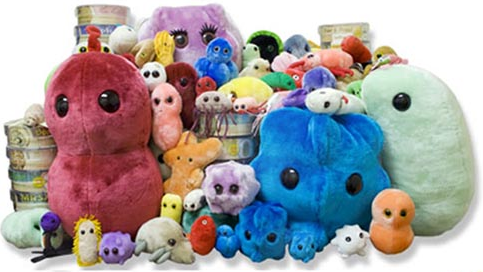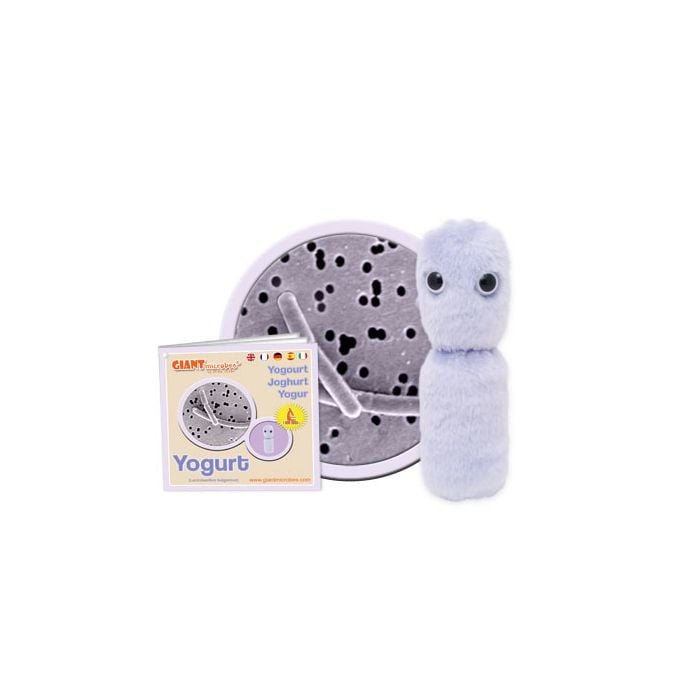Yogurt (Lactobacillus bulgaricus)
Product Details
Additional Information
| Sizes | Giantmicrobes are based on actual microbes, cells, organisms and other critters, only 1,000,000 times actual size! Gigantic (GG) 40-60cm XL (XL) 25-38cm Original (PD) 12-20cm Minis (MM) 5-10cm each Keychain (KC) 5-10cm with clip |
|---|---|
| Materials | Plush from all new materials. Stuffed with polyester fiber fill. Surface washable: sponge with water & soap, air dry. |
| Packaging | Each plush microbe includes a printed card with fun, educational and fascinating facts about the actual microbe or cell. |
| Safety | Every product meets or exceeds U.S. and European standards for safety. For ages 3 and up. |
All about Yogurt (Lactobacillus bulgaricus)
FACTS: Yogurt is a Turkish word for a Middle Eastern dish that is nothing more than milk deliciously fermented by particular strains of common bacteria. It has been made for at least four thousand years, and it may be as old as civilization itself!
How yogurt was discovered is of course unknown. But the warm climate of the Middle East would have caused milk to curdle rapidly. In many instances, the bacterial strains present in the milk would have created poisonous toxins causing it to spoil. However, at some point, certain bacteria would have curdled the milk in such a way that it not only tasted good, but also was preserved. (Technically speaking, the lactose sugars would have been converted into the lactic acid that gives yogurt its distinctive flavor.) If more milk were then added to the spontaneously grown yogurt, the bacterial cultures would have continued to flourish – and more yogurt would have been made.
The process for making yogurt has been known for ages. But it was not until the beginning of the 20th century that Russian microbiologist Ilya Mechnikov discovered, while studying the habits of long-lived Bulgarians, the microorganisms that were responsible for this miraculous transformation of milk. Mechnikov named the primary yogurt-producing bacterium Lactobacillus bulgaricus in their honor. (The other is called Streptococcus thermophilus.)
Dr. Mechnikov believed that the life-giving qualities of cultured milk products might extend life-expectancy up to 150 years! Food for thought when it comes to including yogurt in your diet…
| Description | It produces hydrogen peroxide and enzymes to help break down the food we eat. Acid byproducts from digestion create an undesirable environment in the human gut for harmful bacteria, or pathogens. This prevents pathogens from attaching to the gut and causing damage. |
|---|
| Name | Lactobacillus comes from Latin root words lacto- and baci-, meaning milk rod. It’s species name is Bulgaricus because it was once only found in Bulgaria and used specifically to make Bulgarian yogurt. |
|---|
| Actual Size | 0.8 x 9.0 micrometers, which is about one thousand times smaller than a grain of rice! |
|---|
| Where It Lives | Lactobacillus bulgaricus is one of the species of bacteria naturally found in the human body, also known as normal flora. It’s used to make yogurt, Swiss cheese and probiotic supplements to promote digestive health. |
|---|
| History | It was discovered in 1905 by Dr. Stamen Grigorov, a Bulgarian physician and microbiologist. |
|---|
| Fascinating Facts | In 1908, Russian scientist and Nobel Laureate, Ilya Metchnikoff, discovered a link between eating yogurt with the longevity of Bulgarian people. Today, yogurt has become a billion dollar industry in the United States. |
|---|





